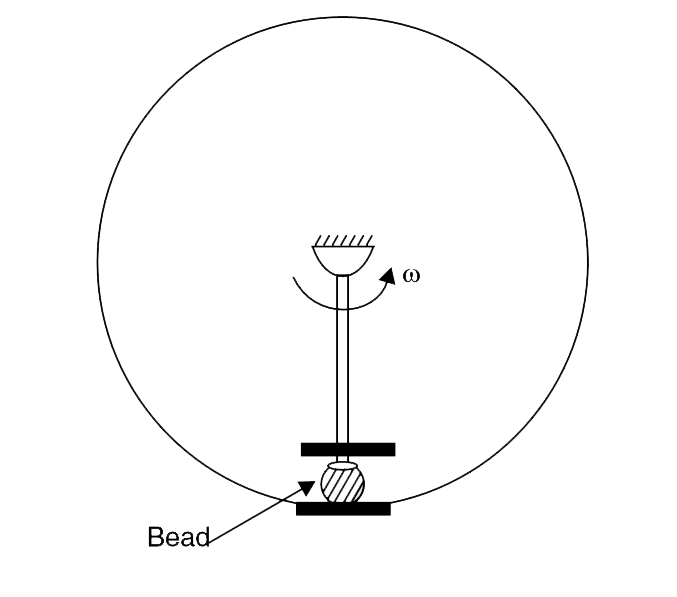A rigid object is rotating in a counterclock wise sense around a fixed axis. If the rigid object rotates through more than 180∘ but less than 360∘, which of the following pairs of quantities can represent and initial angular position and a final angular position of the rigid object -
3rad,6rad
−1rad,1rad
1rad,5rad
−1rad,2.5rad
The correct Answer is:C, D
π<Δθ<2π
3.14rad<Δθ<6.26rad.
Similar Questions
A disk can rotate about its central axis like a merry-go-round. Which of the following pairs of values for its initial and final angular positions, respectively, give a negative angular displacement: (a) -3 rad, +5 rad, (b) -3 rad, -7 rad, ( c) 7 rad, -3 rad?
View SolutionLight rays frorn 'nearby objects (less than 6 meter) are diverging and .from distant objects (more than 6 meter)are parallel. For seeing distant objects, which of the following would occur?
View Solution
Knowledge Check
A : When a rigid body rotates about any fixed axis, then all the particles of it move in circles of different radii but with same angular velocity.
R : In rigid body relative position of particles are fixed.AIf both Assertion & Reason are true and the reason is the correct explanation of the assertion,BIf both Assertion & Reason are true but the reason is not the correct explanation of the assertion,CIf Assertion is true statement but Reason is false,DIf both Assertion and Reason are false statements,A rigid body is in pure rotation, that is, undergoing fixed axis rotation. Then which of the following statement(s) are true?
AYou can find two points in the body in a plane perpendicular to the axis of rotation having the same velocity.BYou can find two points in the body in a plane perpendicular to the axis of rotation having the same acceleration.CSpeed of all the particles lying on the curved surface of a cylinder whose axis coincides with the axis of rotation is the same.DAngular speed of the body is the same as seen from any point in the body.A horizontal rod rotates about a vertical axis through one end. A ring, which can slide along the rod witgour friction, is initially close to the axis and then slides to the other end of the rod. In this process, which of the following quantities will be conserved?
{L = angular momentum, ET = total kinetic energy, ER = rotational kientic energy.]AL onlyBL and ET onlyCL and ER onlyDET only
A rigid mass less rod of length L is rotating in a vertical plane about a horizontal axis passing through one of its ends. At the other end of the rod there is a mass less metal plate welded to the rod. This plate supports a heavy small bead that can slide on the rod without friction. Just above the bead there is another identical metal plate welded to the rod. The bead remains confined between the plates. The gap between the plates is negligible compared to L. The angular speed of the rod when the bead is at lowest position of the circle is ω=2√gL. How many times a clink of the bead hitting a metal plate is heard during one full rotation of the rod ?

View SolutionAngular momentum of a rigid body rotating about a fixed Axis with angular velocity →ω
View SolutionDoes a body rotating about a fixed axis have to be perfectly rigid for all points on the body to have the same angular velocity and the same angular acceleration ?Explain.
View SolutionA rigid electric dipole is force to move in the electric field represented in the figure. Which one of the following phrases most accurately describes the initial motion of the dipole if it released from rest in the position shown ?

View SolutionThe general motion of a rigid body can be considered to be a combination of (i) a motion of its centre of mass about an axis, and (ii) its motion about an instantaneous exis passing through the centre of mass. These axes need not be stationary. Consider, for example, a thin uniform disc welded (rigidly fixed) horizontally at its rim to a massless, stick as shown in the figure. When the disc-stick system is rotated about the origin on a horizontal frictionless plane with angular speed ω the motion at any instant can be taken as a combination of (i) a rotation of the disc through an instantaneous vertical axis passing through its centre of mass (as is seen from the changed orientation of points P and Q). Both these motions have the same angular speed ω in this case

Now consider two similar system as shown in the figure: Case (a) the disc with its face vertical and parallel to x-z plane, Case (b) the disc with its face making an angle of 45∘ with x-y plane and its horizontal diameter parallel to x-axis. In both the cases, the disc is welded at point P, and the systems are rotated with constant angular speed ω about the z-axis.

Which of the following statements regarding the angular speed about the instantaneous axis (passing through the centre of mass) is correct?
View Solution
